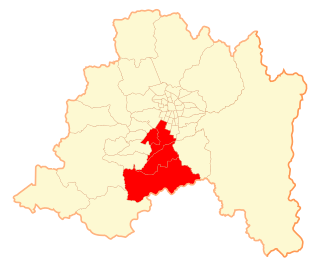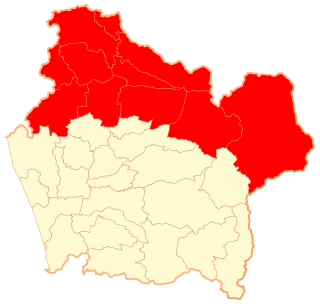
Chile has a long history in the production of wine, with roots dating back to the 16th century when the Spanish conquistadors introduced Vitis vinifera vines to the region. In the mid-19th century, French wine varieties such as Cabernet Sauvignon, Merlot, Carmenère, and Franc were introduced. During the early 1980s, the Chilean wine industry underwent a renaissance with the introduction of stainless steel fermentation tanks and the use of oak barrels for aging. This led to a rapid growth in exports as quality wine production increased. The number of wineries in Chile rose from 12 in 1995 to over 70 in 2005.

The Libertador General Bernardo O'Higgins Region, often shortened to O'Higgins Region, is one of Chile's 16 first order administrative divisions. It is subdivided into three provinces. It is named in honour of Bernardo O'Higgins Riquelme, one of Chile's founding fathers.

The Maule Region is one of Chile's 16 first order administrative divisions. Its capital is Talca. The region derives its name from the Maule River which, running westward from the Andes, bisects the region and spans a basin of about 20,600 km2. The Maule river is of considerable historic interest because, among other reasons, it marked the southern limits of the Inca Empire.

Parral is a city and commune in the Linares Province of Chile's Maule Region.

Rancagua is a city and commune in central Chile and part of the Rancagua conurbation. It is the capital of the Cachapoal Province and of the O'Higgins Region, located 87 km (54 mi) south of the national capital of Santiago.

Curicó Province is one of four provinces of the central Chilean region of Maule (VII). Its capital is the city of Curicó. It lies between the provinces of Colchagua and Talca and extends from the Pacific to the Argentine frontier, spanning an area of 7,280.9 km2 (2,811 sq mi). According to the 2002 census, the population was 244,053.

Curicó is a city located in Chile's central valley and serves as the capital of the Curicó Province, which is part of the Maule Region. Positioned between the provinces of Colchagua and Talca, the region stretches from the Pacific Ocean to the border with Argentina.

Maipo Province is one of six provinces in the Santiago Metropolitan Region of central Chile. Its capital is San Bernardo.

Colchagua Province is one of three provinces of the central Chilean region of O'Higgins (VI). Its capital is San Fernando. It is bordered on the north by Cachapoal Province, on the east by the Argentine Republic, on the south by Curicó Province, and on the west by Cardenal Caro Province.

Malleco Province is one of two provinces in the southern Chilean region of La Araucanía (IX). Its population as of the 2017 census is 205,124, and it covers an area of 13,433.3 km2 (5,187 sq mi). The provincial capital is the city of Angol.

Cafayate is a town located at the central zone of the Valles Calchaquíes in the province of Salta, Argentina. It sits 1,683 metres (5,522 ft) above mean sea level, at a distance of 189 kilometres (117 mi) from Salta City and 1,329 kilometres (826 mi) from Buenos Aires. It has about 12,000 inhabitants.

Lolol is a Chilean commune and town in Colchagua Province, O'Higgins Region.

Cachapoal Province is one of three provinces of the central Chilean region of O'Higgins (VI). Its capital is the city of Rancagua.
Melipilla is a Chilean commune and capital city of the province of the same name. It is part of the Santiago Metropolitan Region and is a significant satellite city of the Chilean capital.

San Antonio is a Chilean port city, commune, and the capital of the San Antonio Province in the Valparaíso Region. It has become the main freight port in Chile, surpassing Valparaíso in the 21st century. San Antonio is also the hub of the fishing area that stretches along the Chilean coast from Rocas de Santo Domingo to Cartagena.

Santa Cruz is a Chilean city and commune, located in the Colchagua valley, in the O'Higgins Region, located on the southern shore of the Tinguiririca river, 110 miles from Santiago, Chile's capital city, and 27 miles from San Fernando.

Colchagua Club de Deportes or just Colchagua is a chilean Football club, their home town is San Fernando in Chile. They currently play in the Tercera Division A of Chilean football, which is actually the fourth division on chilean football due to ANFP ruling. Its traditional rivals are Rancagua Sur and O'Higgins both from the city of Rancagua in the O'Higgins Region which is where San Fernando is also located, it also has rivalry with General Velásquez from the nearby town of San Vicente and with Deportes Santa Cruz. They also share some kind of brotherhood and «healthy» rivalry at the same time with Curicó Unido from the city of Curicó in the Maule Region, this is because San Fernando and Curicó are both pretty close to the regional border between O'Higgins and Maule, both cities are approximately 45 minutes away from each other, so when the La Granja stadium started it's reconstruction during early 2010, Colchagua let Curicó Unido play as local at the Jorge Silva Valenzuela stadium in San Fernando, these two teams dispute the Clásico Huaso because both teams are located in the denominated Zona Huasa of the country.
Cono Sur Vineyards & Winery is a subsidiary of Concha y Toro Winery and is the third largest exporter of bottled wine in Chile. Established in 1993, its name is a reference to its location in the Southern Cone of South America and a play on the word connoisseur. In 2015, it was the official wine of the Tour de France.

The history of Pichilemu began around the 16th century, when Promaucaes inhabited the modern Pichilemu region. According to Chilean historiographer José Toribio Medina on his book Los Restos Indígenas de Pichilemu (1908), Spanish conqueror Pedro de Valdivia gave Topocalma encomienda, in which Pichilemu was supposed to be, to Juan Gómez de Almagro, on January 24, 1544.

Pichilemu, originally known as Pichilemo, is a beach resort city and commune in central Chile, and capital of Cardenal Caro Province in the O'Higgins Region. The commune comprises an urban centre and twenty-two villages, including Ciruelos, Cáhuil, and Cardonal de Panilonco. It is located southwest of Santiago. Pichilemu had over 13,000 residents as of 2012.
























